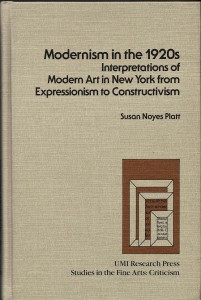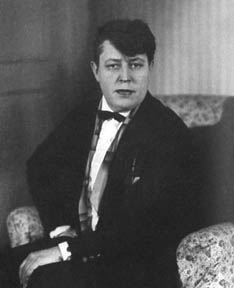Modernism in the 1920s
Modernism in the 1920s Interpretations of Modern art in New York from Expressionism to Constructivism, UMI Research Press, Studies in the Fine Arts: 1985.
In this book, I analyze the ways in which the idea of modernism in art constantly changed in the years before it was codified and institutionalized, principally by Alfred Barr at the Museum of Modern Art. I do this by looking at art criticism from the 1920s ranging from anonymous newspaper articles to publications by prominent and educated art collectors, many of whom, like Katherine Dreier, wrote entire books on the meaning of modern art.
At the beginning of the book, I introduce institutions, galleries, dealers and then, in the next chapter, art critics, but the main ordering device of the book is style-Expressionism, Cubism, Surrealism, etc. In this way I am able to demonstrate a range of different perspectives that have been lost in subsequent decades, (see my article “Modernism, Formalism and Politics: the 1936 ‘Cubism and Abstract Art Exhibition at the Museum of Modern Art,” Art Journal, Winter 1988, pp. 284-295).
I embrace the fact that everyone could come to modern art with their own point of view and there was constant discussion, argument, contradiction and changing opinions. Two larger frameworks, formalism and expressionism dominate the majority of perspectives, but within those two concepts there were many different definitions. There was, in fact, an obsession with interpreting and defining the history of modern art by everyone who showed it
I include the interpretation of art by European Cubists, Surrealists, Suprematists and Constructivists. In other words, the intersection of European and US based modernism is a constant theme in the 1920s, with US artists benefitting from this rich exchange, although by 1930 there was a reaction against the “influx” from Europe which led to Regionalism and “nativism.”.
Flora Turkel, based in Berlin provided much discussion of Russian art, the Bauhaus and the “Neue sachlichkeit”. Guy Eglington, of the International Studio (who drowned at a young age), is also discovered as a sophisticated writer on modern art, New Yorker critic Murdock Pemberton wrote frequently on modern art. Even anonymous writers on art contributued important ideas.
Jane Heap, whom one of my dissertation advisors, Richard Brettell, referred to as the hero of the dissertation, emerges as a brilliant, eccentric commentator on Dada and Surrealism as well as Russian avant-garde art in her “Machine Age” exhibition and in the pages of her publication The Little Review. She was the first American writer and publisher to present Brancusi’s own photographs of his work, the Dada artists, and the art of the Russian Revolution including Tatlin’s Tower. Leger, Picabia, and Moholy-Nagy all contributed to the magazine.
At the end of the book, I point toward the future with the establishment of the Gallery of Living Art and the founding of the Museum of Modern Art
The book looks in depth at the language of art criticism, thinking about the changing meaning of words, the constantly evolving perceptions. We are so accustomed to our usual hierarchy of the importance of Cubism and Picasso, as the primary event of 20th century art, with everything else revolving around it, that it is both refreshing and crucial that we remember that up until the mid 1930s, there was no consensus on that idea.
This book is based on my dissertation for the University of Texas, Austin, “Responses to Modern Art in New York in the 1920s,” although it is about half the length.
This book is available from the author at a price of $50. Plus $ 10-15..shipping, depending on your location. Use the contact form on this website for more information. Or use Pay Pal button below.










